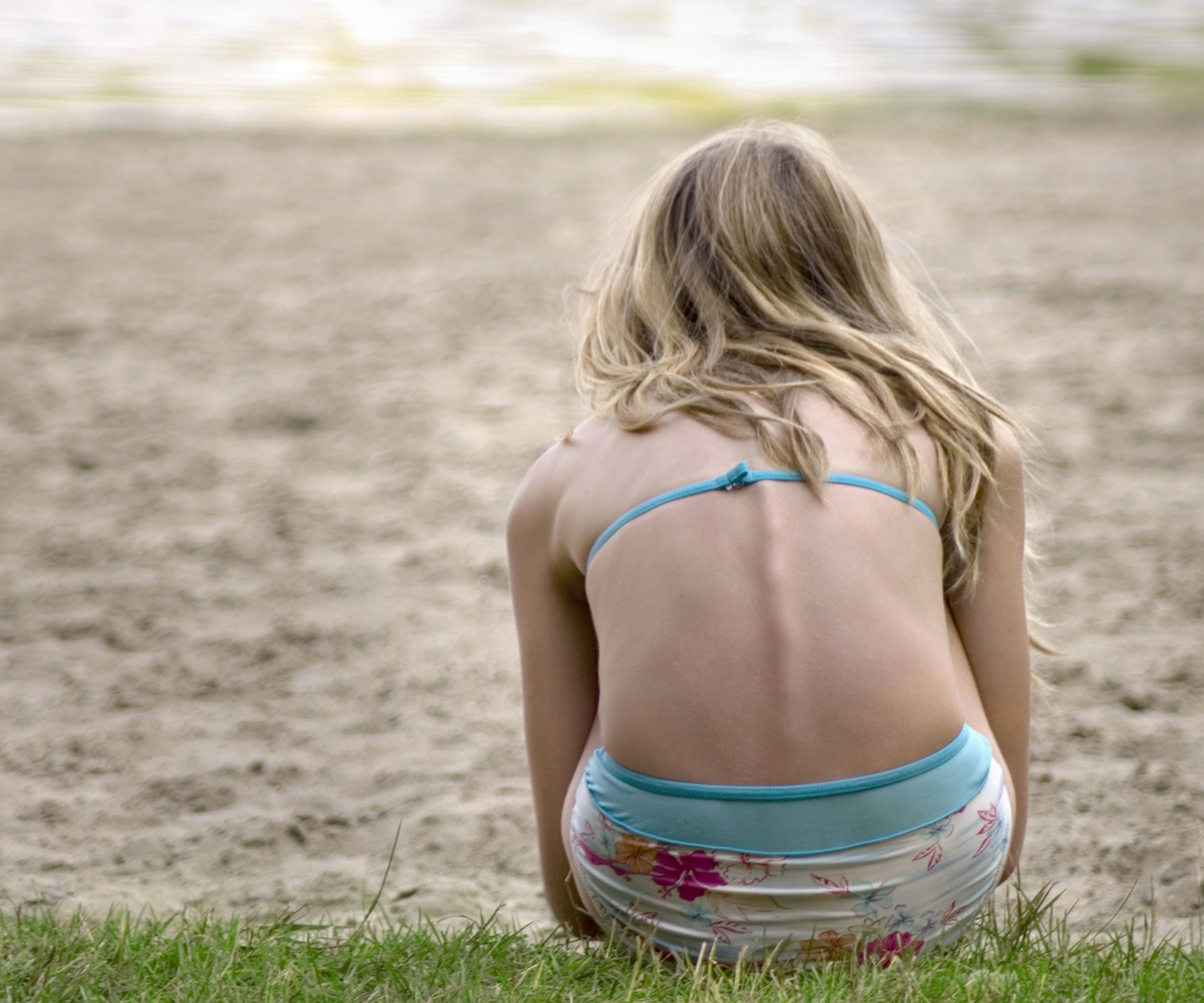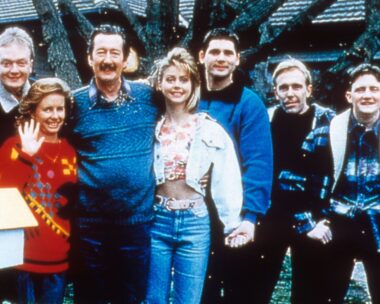Trigger warning: This post includes a personal account of eating disorders. It may be distressing to some readers.
She was calm and empathetic, this woman before us. Stylish and professional, she perched on the edge of a Queensland public health armchair.
How could she understand? This put-together woman in edgy fashion and head-turning stilettos. My husband and I had just overpowered our youngest child, our 11-year-old daughter.
He had wrapped himself around her shoulders, pinning her arms and avoiding her teeth while I squeezed my arms around her kicking and flailing legs.
We struggled down our front stairs in tears, as if landing a thrashing, angry marlin, hating ourselves, but seeing no other way.
In sheer desperation to bring our baby girl to this woman, we had overpowered her and lifted her into the back seat of the car, child locks engaged.
I wrapped my arms and legs around hers to prevent her from unclipping her safety belt and kicking at her father as he began the drive to the Gold Coast.
Still, she managed to connect a foot with his head and he flinched as he manoeuvred through Brisbane’s Coronation Drive traffic.
Now we were in a small meeting room at the Gold Coast Child & Youth Mental Health Service. Before us was the woman we had been told could help us, if anyone could. And there was the catch: if anyone could.
Hazel had been an active kid growing up in Brisbane. She loved animals, playing in our backyard creek and searching for fairies on morning walks with her dad. She had revelled in being the only girl on her soccer team.
Wild blonde waves streamed back from her open face, a ready grin and mischievous streak a mile wide. She would chatter incessantly, then pause and declare, “I really want to keep talking, but I can’t think of anything else to say!” A clever perfectionist, she became anxious and unstuck when sharing control in team projects.
Looking back, I suspect my husband and I were in denial for the first three weeks of the 2013 school year. Usually a hearty eater, Hazel merely cut up, mashed and rearranged her food at dinner. She pleaded a stomach ache and asked to leave the table.
Chicken breast and fish became “too fatty”. Milk, cheese, butter and yogurt triggered a disgusted grimace. One Sunday, as she played with our old dog, it hit us like a punch. Her legs were pale matchsticks in little denim shorts and her head looked disproportionately large. Hazel looked distorted. Stretched.
We finally spoke the word we had been avoiding: anorexia.
I had read about it in magazines, feeling sorry for these women with ravaged bodies and tattered lives, then turning the page. Didn’t anorexia happen to self-absorbed models? My daughter didn’t have shallow values. She wasn’t a woman. She wasn’t even a teenager. She was an 11-year-old who still slept with the light on and loved Harry Potter. How could this happen?
Our local GP, our health guru for the past 16 years, confirmed anorexia, but didn’t know of any treatment options for children. Hazel was too young for a private clinic, so we left with the name of a psychiatrist who worked with children and teenagers.
The first available appointment was a month away. I served fish and chips, once a childhood treat. It smacked the wall and slid to the floor in a congealing mess.
We discovered that Hazel was throwing away her lunch at school, running and exercising to accelerate the weight loss. We argued over grains of rice and individual cornflakes while she denied that she had anorexia.
Sometimes, when we were all exhausted, Hazel would sadly say that she was sorry, but the scary feeling in her brain would not let her eat. It never rested – it was always vigilant and would punish her severely for defying it. There was no fight in her, just a sombre resignation.
When we finally met the psychiatrist, she said we just needed to be stricter, reminisced about her own regimented childhood and told Hazel to buck up, obey her parents and to eat properly.
We saw a nutritionist who declared that our girl had merely “forgotten” to snack. She handed over a list of low-fat, low-calorie snacks and we were out the door with her bill and a very smug young anorexic.
It was now April and Hazel faded a little more every day. She grew wraith-like and lethargic. We had a diagnosis, but where could we turn for help? I calculated my sick leave and carer’s leave, and took it all, eventually losing my job anyway.
At 152 centimetres, Hazel was just 32kg. Her Body Mass Index, calculated on height and weight, was 13.8. Various websites told me it should have been 18-19. “This child is underweight and should be seen by a healthcare provider,” the online BMI calculator admonished.
I researched obsessively. Anorexia has a mortality rate twice that of other psychiatric disorders, Iread. The suicide rate was 200 times that of the general population. Recovery took an average of five to seven years and patients risked kidney failure, osteoporosis and compromised immunity. Just 46 per cent would recover fully and permanently. Others would relapse and about 20 per cent would never recover.
The most promising treatment for under-18s seemed to be the Maudsley Family Based Therapy (FBT), developed at the Maudsley Hospital in London. Trials were reporting that 89 per cent of patients were reaching 90 per cent of ideal body weight. My husband reached out to a former school friend who was now with the Eating Disorders Association. She gave us the name of the woman she believed could rescue Hazel.
So now we sat in a small room overlooking a suburban roundabout with Kim Hurst, Senior Psychologist with the Gold Coast Child & Youth Mental Health Service.
We talked for what may have been two hours. Kim told Hazel firmly but kindly that if she didn’t eat she would be hospitalised – not as a punishment, but to save her life.
Within a week or two, Hazel’s condition had deteriorated drastically. She collapsed in the shower, regaining consciousness as I dragged her wet body onto a bed. At the next check-up, her weight and pulse triggered back-office phone calls and murmured conversations. Hazel hissed through gritted teeth that she would kill herself if admitted to hospital.
We stayed overnight at the Gold Coast, awaiting advice. It came in a phone call the following morning. The day before her 12th birthday, Hazel was admitted to the tired old Gold Coast Hospital.
Hazel was allocated to a four-bed ward on the paediatric floor. Nurses inserted a tube through her nose, down to her stomach, then connected it to a drip containing a high-nutritional formula. This would run day and night for weeks. Cardiac and respiratory monitors were glued over her chest and back. Bedpans arrived.
She was forbidden from leaving her bed for the first week. Even taking a wheelchair to the toilet posed an unacceptable risk to her heart. Hazel awoke on her 12th birthday looking like a pale prisoner caught in the centre of a web of wires.
The green vinyl armchair beside her folded out into a camp bed. This corner of the ward became our home for the next six weeks.
The average brain needs 500 calories a day to run properly. Hazel wasn’t allowing herself this basic amount, let alone the fat, protein, carbohydrates and nutrients needed to keep the rest of her body functioning and growing.
In the first week, Hazel sat up in bed to brush her hair and the cardiac monitor raced up to 167 beats per minute.
The drip kept Hazel hydrated and “fed”. For the first few days, she allowed nothing to pass her lips. Eventually, she accepted morsels: a spoonful or two of yogurt, a cracker, some rice. Progress was slow and painful. There were tears, hysteria and refusals, but there were also times when I glimpsed my frightened little girl, looking out from inside her wracked frame.
After six weeks, Hazel had reached 39kg and we were discharged. That’s when the real fight began.
Under Kim’s guidance, we restarted Family Based Therapy (FBT). During the first stage, the entire family attends weekly therapy sessions focused on refeeding.
Saying goodbye to the nurses, packing up and driving north on the Pacific Motorway in June 2013, I was delighted to be bringing Hazel home. Eating was still difficult and prolonged, but she was out of medical danger.
The next morning, having missed our 14-year-old son tremendously during the weeks in hospital, I drove him to his Saturday soccer match. We were still at the field when my husband called.
Hazel was refusing to eat. She explained that she had been planning to come home to die. She had rowed our little boat to the middle of the waterhole, determined to slip over the edge and beneath the cold, dark water.
Countless times, I phoned Kim in tears. Hazel had put on her best black dress and tried to climb over the second-storey deck railings and jump. In a hysterical rage, she had burst through the flyscreen on her window, again ready to jump. She had taken a handful of Nurofen. She had cut her wrists with a kitchen knife. With a plastic shaver. With scissors. And her weight was dropping.
Leaving a check-up one day, she bolted and climbed the barrier wall of a multi-storey car park. It took all my strength to pull her back down. She would take off her seatbelt and open the car door while we drove at 110km an hour to appointments at the Gold Coast. Hazel would fast for two days, then double up in pain as her intestines cramped.
Nothing –firmness, pleading, anger, reasoning, removing privileges – could convince her to eat. Sometimes she was manipulative. Sometimes she would sadly shake her head, drape her arms tiredly around my neck and close her eyes. At other times, the sight of food would drive her into a violent, abusive rage where she would throw table lamps, plates, books and climb over furniture to escape a room where there was food.
We locked up the knives. I bought a safe for our medications. We replaced the flyscreen with a steel screen in her bedroom. When driving, we engaged the child locks and made her sit in the back.
When she unbuckled herself, I pulled over and refused to drive any further. Coming home from an appointment one night, she vaulted into the front seat and tried to flee onto the dark, roaring motorway.
I gripped her ripping blouse while my husband, who I phoned from the car, threatened to call 000.
“Suicidal ideation is about feeling so out of control that you don’t think there’s any other option,” Kim says. “It’s a lever anorexia uses to get parents to back off.”
For months, Hazel and I slept together in her single bed. Anorexia sometimes drove her to attempt dozens of push- ups, sit-ups or star-jumps in the middle of the night – anything to burn calories.
Kim became a beacon of rationality and empathy through the turmoil of our lives. She could see progress where we saw pain. She empathised and encouraged us to hold our nerve. She reinforced the importance of allowing no “gaps” in the wall against anorexia.
We had to be watertight: stronger, more determined, more relentless and more loving than the illness. That meant breakfast merging into morning tea merging into lunch merging into snack merging into dinner and then another snack before we hit that single bed together. What worked for three days might not work on the fourth. Anorexia was a shape-shifter and we had to recognise and block it every time.
Kim taught us to visualise anorexia as an intruder, a beatable enemy. We could not allow Hazel to see the disease as a part of herself.
At times, our emotions exploded. I shouted, Hazel scratched, we wrestled. Kim shored up our collapsing confidence in our parenting skills. “No amount of being the best parent ever, or having the best household, will make you immune from this,” she says.
After some weeks, Hazel returned to school. She began to conquer her list of feared foods, sometimes visibly shaking as snack time approached, but at other times fronting up proudly to tell Kim of her afternoon tea triumphs. I would meet her near the school fence five days a week and we ate lunch together. When I couldn’t make it, my husband was there, encouraging her to eat.
Yet, in the 2013 summer holidays, Hazel grew anxious about starting high school and anorexia returned with a vengeance. We battled the relapse for much of 2014.
Over time, Hazel’s eating has normalised. She still has issues with body dysmorphic disorder (wrongly believing that she is obese and ugly) and acute anxiety.
“Anorexia can be eradicated,” Kim says. “You can recover. You can get your life back.”
We have one appointment left with our “anorexia whisperer”, a family celebration meal. Hazel can’t wait to show Kim her new love of teppanyaki. She still has mountains to climb, but our daughter is back.
Hazel’s name has been changed to protect her identity.
Anyone needing support with eating disorders or body image issues is encouraged to contact the Butterfly National Eating Disorders Support Line on 1800 33 4673.
This story originally appeared in the March 2016 issue of The Australian Women’s Weekly.




